Click on images to enlarge
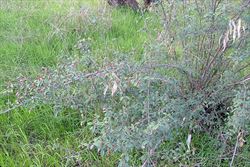
habit (Photo: Sheldon Navie)
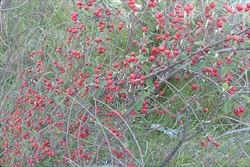
habit in fruit (Photo: Sheldon Navie)
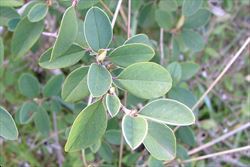
leaves (Photo: Sheldon Navie)

very hairy leaf undersides (Photo: Sheldon Navie)
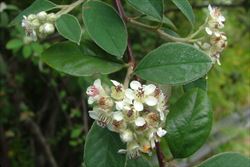
flower clusters (Photo: Sheldon Navie)
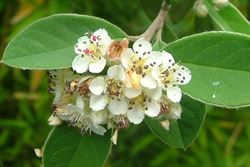
close-up of flowers (Photo: Sheldon Navie)

young fruit (Photo: Sheldon Navie)
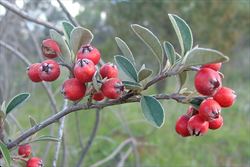
mature fruit (Photo: Sheldon Navie)

close-up of mature fruit (Photo: Sheldon Navie)
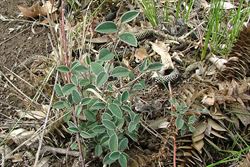
young plants (Photo: Sheldon Navie)
Scientific Name
Cotoneaster pannosus Franch.
Family
Malaceae (New South Wales)Rosaceae (Queensland, the ACT, Victoria, Tasmania, South Australia and Western Australia)
Common Names
cotoneaster, silver cotoneaster, silver leaf cotoneaster, silverleaf cotoneaster, silver-leaf cotoneaster, silver-leaved cotoneaster, velvet cotoneaster
Origin
This species is native to south-western China.
Cultivation
A popular garden plant (i.e. ornamental) in southern and eastern Australia.
Naturalised Distribution
Naturalised around populated areas mostly in the south-eastern parts of the country. It is most common in the coastal and sub-coastal regions of New South Wales, Victoria and Tasmania. Less common or scattered in the ACT, south-western Western Australia, south-eastern South Australia and south-eastern Queensland. Also naturalised on Lord Howe Island.
Naturalised overseas in southern Africa, western USA (i.e. Oregon and California) and Hawaii.
Habitat
A weed of urban bushland, grasslands, open woodlands, forest margins, waterways, roadsides, railway lines, disturbed sites and waste areas in temperate and sub-tropical regions.
Habit
An upright (i.e. erect) or arching shrub usually growing up to 2 m tall, but occasionally reaching up to 5 m in height.
Distinguishing Features
- an upright or arching shrub (growing up to 2 m tall) with young stems that are densely woolly hairy.
- its relatively small leaves (10-40 mm long and 8-16 mm wide) have dull green and hairless upper surfaces.
- the leaf undersides are densely hairy and silvery-whitish in appearance.
- its small white flowers (8-10 mm across) are borne in dense clusters and each flower has five spreading petals.
- its small red 'berries' (5-8 mm across) are rounded or egg-shaped.
Stems and Leaves
The upright (i.e. erect) stems grow in a somewhat spreading and arching nature as the plant matures. Young stems are densely covered in white hairs, giving them a woolly appearance. Older stems and branches are dark greyish-brown or purplish-brown and are hairless (i.e. glabrous).
The alternately arranged leaves are relatively small (10-40 mm long and 8-16 mm wide) and borne on hairy stalks (i.e. tomentose petioles) 2-8 mm long. They are egg-shaped in outline (i.e. ovate) or oval (i.e. elliptic) in shape, with pointed or rounded tips (i.e. acute or obtuse apices) and entire margins. Their upper surfaces are a dull green colour and are hairless (i.e. glabrous) or slightly hairy (i.e. sparsely pubescent), while their lower surfaces are silvery or whitish and densely hairy (i.e. tomentose).
Flowers and Fruit
The small white flowers (7-10 mm across) are borne in dense clusters (i.e. corymbs) along the branches, each cluster usually containing 6-20 flowers. These flowers have five spreading, white, petals (3-3.5 mm long) and are borne on hairy stalks (i.e. tomentose pedicels) 2-3 mm long. They also have five tiny sepals, numerous stamens topped with purplish-red anthers, and two or three styles. Flowering occurs mostly during spring and summer.
The fruit is a small, rounded (i.e. globose) or egg-shaped (i.e. ovoid), 'berry' (i.e. pome) that turns bright or dark red as it matures. These fruit (5-8 mm across) usually contain two 'seeds' (i.e. nutlets or pyrenes) that are 4-5 mm long.
Reproduction and Dispersal
This plant reproduces by seed, which are commonly spread by birds that eat the brightly coloured fruit. The seeds are also dispersed in dumped garden waste and if plants are cut down they will produce suckers from the base (i.e. crown).
Environmental Impact
Silver-leaved cotoneaster (Cotoneaster pannosus ) is a moderately important or significant environmental weed in Victoria, Tasmania, the ACT and New South Wales, and a minor or potential environmental weed in Queensland and South Australia.
Dispersed by fruit-eating (i.e. frugivorous) birds, this species forms thickets along roadsides and in disturbed and undisturbed natural plant communities. These infestations are capable of altering and displacing native plant communities by shading out the native ground flora and impeding the regeneration of overstorey plants.
Other Impacts
The fruit of this species are poisonous to humans. Silver-leaved cotoneaster (Cotoneaster pannosus) can also act as a host for bacterial fireblight, a disease of orchards.
Legislation
This species is declared under legislation in the following states and territories:
- ACT: C4 - prohibited pest plant (a pest plant whose propagation and supply is prohibited).
- Western Australia: Unassessed - this species is declared in other states or territories and is prohibited until assessed via a weed risk assessment (throughout the entire state).
Management
For information on the management of this species see the following resources:
- the Weeds in your Bush section of the Tasmanian Bushcare Toolkit which is available online at http://www.dpiw.tas.gov.au.
Similar Species
Silver-leaved cotoneaster (Cotoneaster pannosus) is very similar to grey cotoneaster (Cotoneaster franchetii), large-leaved cotoneaster (Cotoneaster glaucophyllus), willow-leaved cotoneaster (Cotoneaster salicifolius), milk-flower cotoneaster (Cotoneaster coriaceus) and khasia berry (Cotoneaster simonsii). These species can be distinguished by the following differences:
- silver-leaved cotoneaster (Cotoneaster pannosus) has relatively small leaves (10-40 mm long) with dull greyish-green upper surfaces that are somewhat hairy (i.e. pubescent). The lower surface of the leaves are silvery or whitish and densely hairy (i.e. pubescent). The white flowers have spreading petals and are borne in medium-sized clusters (usually with 6-20 flowers). Its relatively dull and sometimes hairy fruit turn red as they mature and usually contain two 'seeds' (i.e. pyrenes).
- grey cotoneaster (Cotoneaster franchetii) has relatively small leaves (20-35 mm long) with greyish-green upper surfaces that are somewhat hairy (i.e. pubescent) when they are young, but become hairless (i.e. glabrous) and shiny in appearance as they mature. The lower surface of the leaves are silvery or whitish in colour and densely hairy (i.e. pubescent). The pink or pinkish-white flowers have relatively upright (i.e. erect) petals and are borne in medium-sized clusters (usually with 5-15 flowers). Its fruit turn orange or pinkish-orange as they mature and usually contain three 'seeds' (i.e. pyrenes).
- large-leaved cotoneaster (Cotoneaster glaucophyllus) has relatively large leaves (20-80 mm long) with upper surfaces that are smooth and dark green in colour. The lower surface of the leaves are initially greyish-green and covered in whitish hairs (i.e. they are pubescent) but these hairs often wear off as the leaves mature, leaving pale green or slightly bluish-green and hairless (i.e. glabrous) undersides. The white flowers have spreading petals and are usually borne in large clusters (usually with 20-60 flowers). Its relatively glossy fruit turn bright red as they mature and usually contain two 'seeds' (i.e. pyrenes).
- willow-leaved cotoneaster (Cotoneaster salicifolius) has relatively long and narrow leaves (25-90 mm long) with dark green, glossy and hairless (i.e. glabrous) upper surfaces that have prominent veins impressed into them. The lower surface of the leaves are greyish in colour and hairy (i.e. pubescent). The white flowers have spreading petals and are borne in medium-sized clusters. Its fruit turn bright red as they mature and contain two or three 'seeds' (i.e. pyrenes).
- milk-flower cotoneaster (Cotoneaster coriaceus) has relatively large leaves (up to 75 mm long) with shiny dark green and mostly hairless (i.e. glabrous) upper surfaces that have prominent veins impressed into them. The lower surface of the leaves are whitish in colour and densely hairy (i.e. pubescent). The milky white flowers are borne in medium-sized clusters and its fruit turn orange-red or red in colour as they mature.
- khasia berry (Cotoneaster simonsii) has relatively small leaves (about 25 mm long) with bright green upper leaf surfaces that are shiny and have a sparse covering of close-lying (i.e. appressed) hairs. The lower surface of the leaves are greyish-green and also sparsely hairy (i.e. sparsely pubescent). The white or pale pink coloured flowers are borne in small clusters (with only 1-4 flowers). Its shiny fruit turn orange-red or scarlet red in colour as they mature.
Silver-leaved cotoneaster (Cotoneaster pannosus) is also relatively similar to the firethorns (Pyracantha spp.) and the hawthorns (Crataegus spp.). However, the firethorns (Pyracantha spp.) have stems that are armed with spines and the hawthorns (Crataegus spp.) have deeply lobed leaves that are also often coarsely toothed (i.e. serrate) towards their tips and stems that are also armed with stout thorns.

